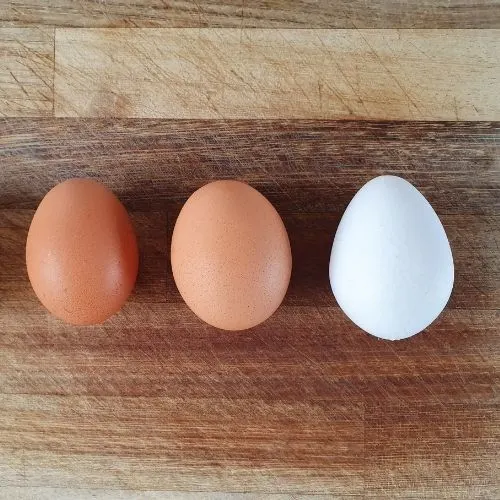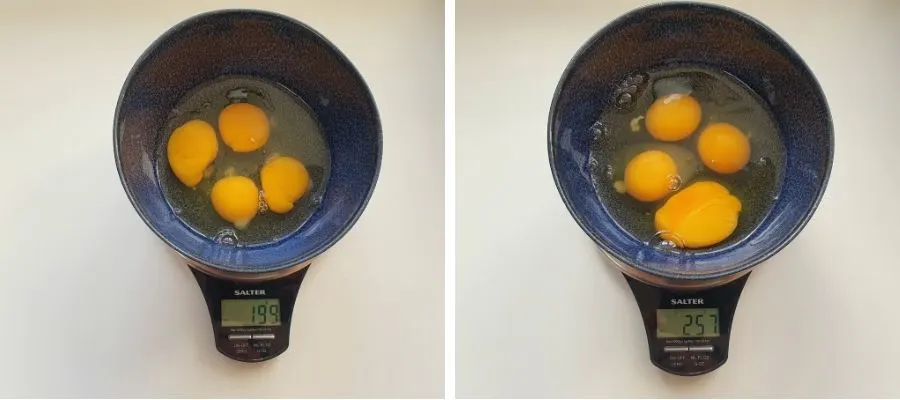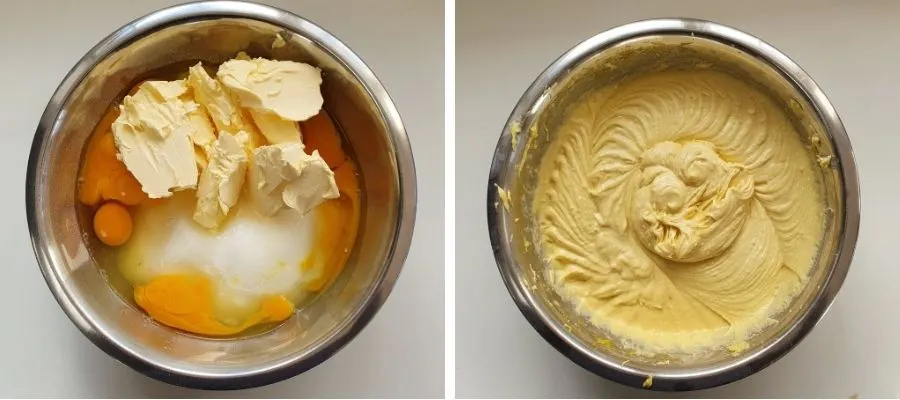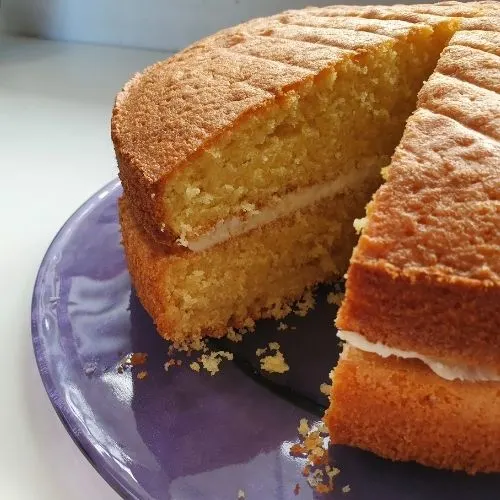Weighing eggs is a traditional method of cake making and one that’s not always used in today’s modern-day recipes, but does it actually make any difference?
As a baker myself and also having baked cakes to sell, I’ve done quite a bit of experimenting with sponge mixes so I could make both the best-looking and tasting sponges for my customers.
The simple answer is; egg weights can range by around 20-30g, so if you don’t know the egg weight the recipe could have too much or too little egg. Weighing the egg gives an accurate weight and excellent texture.

Read on to see a quick and easy way to measure a sponge mix which you can use for various cake sizes including a visual guide and ratio chart which you can use to get the best results every time.
Do You Weigh Eggs in the Shell For Baking?
You might have come across some bakers who weigh their eggs in the shell before cracking it into a cake mix.
So, what I’m about to say might be a bit controversial in the baking world, but trust me I’ve tested it and you will see good results.
The average eggshell weighs around 9-10g, so if you’re weighing the shell you’re adding in extra weight to your cake batter ratio that isn’t there.

For example, if you use six eggs in your cake batter and you include the eggshell weight you’re accounting for around 60g of egg that isn’t in the mix.
The best way to weigh an egg is by cracking the egg straight into a mixing bowl over a set of scales set to zero, that way the shell weight isn’t included in the mix.
Eggs give a cake batter the liquid element of the cake so having the correct ratio prevents the sponge from being too dry and dense.
Why It’s Good to Weigh Eggs for Cakes
Just before we move on to how to weigh eggs and cake mix ratios, I just want to explain how weighing eggs can make a difference to a finished sponge cake.
Eggs play an important role in a cake mix including color (from the yolk), thickening, moisture, creating a structure to bring the ingredients together, and even help with the rising process.
One of the most important elements for a good sponge is moisture and if there’s not enough it can lead to a sponge with a heavy dry texture.
When a recipe states x number of eggs, most people don’t have a variety of sizes to hand, they’ll just use whatever they have.
I measured the weights of smaller eggs vs larger eggs into a bowl to see what the difference would be.
I used four eggs of each type and there was a nearly 60g (2.1oz) difference between the two, which is the same weight as one whole medium egg.
The image below shows the weight of the small eggs (on the left) and large eggs (on the right).

The bigger the cake and the more eggs you need, the bigger the weight difference will be.
This shows that it’s much more accurate to weigh eggs rather than use a specific number, although numbers can be used as a guide.
Some baking is more of an exact science than others, but personally, I think it’s better to be slightly over on egg volume than under.
How to Weigh Eggs for Cake Baking
The easiest way to make a sponge cake batter that will give you good results every time is by using the following ratio:
- 1 part flour (self-raising)
- 1 part sugar
- 1 part fat (baking margarine or butter)
- 1 part eggs
To put this in simple terms all parts weigh the same and by using this ratio the end result should be a sponge with a good texture that isn’t dry.
This is a really easy ingredient ratio to follow, but the fact that each egg weight varies can complicate things a little.
To keep things simple, the best way to use egg weights is to weigh the eggs first and then use the egg weight value for the rest of the ingredients.
For example, I wanted to make quite a large sponge cake using eight eggs, so I cracked 8 various-sized eggs into a mixing bowl that I’d placed on some scales.
The total weight of the eggs came to 450g (15.9oz), so I weighed 450g of each ingredient into the bowl.
For this example, I used the ‘all in one sponge method’ using baking margarine such as Stork, which doesn’t need to be creamed with sugar as butter does and it can all just be mixed together to produce a silky batter.

You can also use the same ratio using butter if you prefer, I’m a big butter fan, but when it comes to cakes I just prefer the results which you get from baking margarine.
By using this method the weights used are governed by the weight of the eggs rather than the other ingredients and it helps to keep the recipe really simple.
Easy Cake Ingredient Ratio Chart
When you use the method above to make a sponge batter and you’re calculating the ingredient weight as per the egg weight, you need an idea of the ingredient amount you need depending on the cake size.
The chart below shows how to calculate sponge batter weights and cake size based on an average egg weight of 2oz (57g):
| Number of eggs | Flour/ sugar/ fat weights | Makes (cake size) |
| 2 | 115g 4oz | Small cake 1lb loaf tin |
| 3 | 170g 6oz | |
| 4 | 225g 8oz | Medium cake 2lb loaf tin |
| 5 | 285g 10oz | |
| 6 | 340g 12oz | |
| 7 | 400g 14oz | Large cake |
| 8 | 450g 160z | |
| 9 | 515g 18oz | |
| 10 | 570g 20oz | Extra large cake |
Top Tip
When you start to mix your batter it’s usually a bit too thick and will produce a sponge that is fairly tight, to loosen up the batter and make a sponge with a good texture, add a tablespoon of milk per three eggs (170g/6oz of ingredients).
This image shows the final cake which I made for this article using eight eggs, I added 3 tablespoons of milk to the mix, which produced a light and fluffy texture.

Articles You Might Find Useful
I hope this article has helped you to find out more about weighing eggs to make cakes, you might also find the following articles useful too:
Should You Weigh Pasta Before or After Cooking?
What Does a Fried Egg Weigh? (With Calories & Conversion Charts)
How Much Does a Poached Egg Weigh? (Charts & Images)
